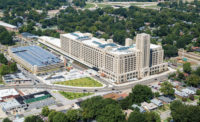Toronto Public Housing Gets Green Makeover
Cities across North America are struggling to undo the mistakes of 20th-century public housing. Some are finding that a clean slate also presents opportunities. In Canada, the Toronto Community Housing Corporation (TCHC) is pushing the agenda on design and sustainability with a $1 billion effort to rebuild an inner city housing project.


A team of architects including architectsAlliance and Diamond and Schmitt has prepared plans to redevelop Regent Park, a 1950s-era public housing complex in Toronto. Breaking apart superblocks, it will replace 2,000 townhouse and mid-rise apartments with more than 5,000 housing units in townhouses and towers. Many of the new buildings will have green roofs and other sustainable features.
Last year, the public agency started a 12-year project to redevelop Regent Park, a 69-acre downtown neighborhood of low-income housing completed between 1948 and 1957. A plan created by a team including architectsAlliance and Diamond and Schmitt seeks to break up the existing super-blocks and reintegrate them with the downtown street grid. It will also replace 2,000 townhouse and mid-rise apartments with more than 5,000 housing units, a mix of subsidized and market-rate condos and townhouses.
The new buildings will be designed to achieve LEED Gold certification, with a coldwater heating and cooling plant for the entire district. “It just seemed that if we were as a public agency going to leave a legacy for the city, it should be the best possible legacy we could,” explains TCHC chief development officer Mark Guslits.
TCHC is applying this idea to other current projects, which are intended to replace some of Regent Park’s affordable housing with new and more varied units around the city. Among the first satellite projects to begin construction is a $23.7-million, 85-unit tower downtown designed by Teeple Architects. Principal Stephen Teeple describes the twelve-story building’s character as “a kind of clear urbanity, cut and opened up by nature and green roofs.” The square-plan tower will be built around a wide, irregularly shaped atrium, with a Piranesian network of planted terraces and a pedestrian bridge across the middle.
The apartments, which range in size from one to four bedrooms, will house members of a hospitality workers’ union, “many of whom happened to live in Regent Park,” Guslits says. And though the building is aiming for only LEED Silver certification, due to budget limitations, it will feature in-suite heat recovery systems, a high-performance cladding system, and extensive daylighting.
The building’s system of green terraces and vertically planted grow walls will be irrigated by a rooftop cistern. These will function both as spaces where residents can socialize, and they will supply produce for a restaurant and training kitchen, to be staffed by union members, located on the building’s ground floor. Teeple says that this street-front presence makes an important gesture on a commercial block that, like Regent Park itself, is in transition. “We’re trying to show that you can have good urban design and still make a very sculptural, very memorable, magical building.”


